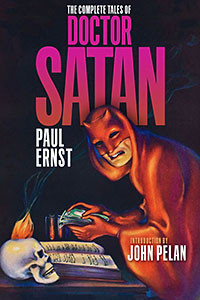 The Complete Tales of Doctor Satan
The Complete Tales of Doctor Satan
For enthusiasts of pulp magazines, Weird Tales stands as a monumental publication, renowned for its long run in the occult, horror, and fantasy genres. It served as a launchpad for literary giants like H.P. Lovecraft and Seabury Quinn. While Weird Tales featured recurring characters, its notable venture into the realm of “hero pulps”—or, more accurately, “villain pulps”—was the short-lived but impactful series starring Doctor Satan. Crafted by the prolific pulp writer Paul Ernst, best known for The Avenger, Doctor Satan graced the magazine covers and captured the imaginations of readers, and now his tales are available in “The Complete Tales of Doctor Satan” from Altus Press.
Doctor Satan holds a unique position in pulp history as one of the most enduring pulp villains, headlining eight stories within a single year, from August 1935 to September 1936. He marked his presence on the cover twice, for his debut and seventh installments. However, despite the precedent of occult detective stories in Weird Tales, exemplified by the 90-story run of Jules de Grandin, readers reportedly didn’t embrace Doctor Satan, feeling the magazine was straying from its established identity.
The narratives of Doctor Satan are fundamentally structured around the conflict between the eponymous villain and Ascott Keane, an independently wealthy occult detective operating as a dilettante. Keane is supported by his resourceful secretary and assistant, Beatrice Dale. Notably, both Doctor Satan and Keane wield genuine occult powers, setting them apart from mere charlatans.
Doctor Satan’s arsenal of threats was a blend of the occult and technological marvels. His schemes included creating deadly plants that sprouted from human skulls, animating corpses to impersonate kidnap victims, and wielding rays capable of rendering skin transparent. Yet, these terrifying powers were often deployed for surprisingly mundane purposes: extortion. Despite seemingly not needing the money, Doctor Satan used these incredible abilities merely to terrorize, a curious underutilization of his potential for grander villainy.
Doctor Satan’s visual identity is striking: a red cloak, a face-concealing red mask, and a horned red skull cap. His true identity remains shrouded in mystery, with hints suggesting a wealthy, bored individual who drifted into a life of crime. He is aided by a peculiar pair of henchmen: Girse, a monkey-like dwarf, and Bostiff, a legless giant. The role of assistant to Doctor Satan is perilous; midway through the series, one assistant meets his demise, followed by the other a few stories later. However, given Doctor Satan’s mastery over life and death, their resurrections remain a possibility.
In John Pelan’s introduction to the Altus Press collection, he delves into Doctor Satan’s character and inherent weaknesses. The motivation of a bored rich man turning to crime does feel somewhat underwhelming. Interestingly, the popular image of Doctor Satan often deviates from the original pulp depictions. While the stories describe a full face mask, modern interpretations frequently depict him with a half-face mask, sometimes complemented by a Van Dyke beard, as seen on some covers. Furthermore, in several stories, Doctor Satan employed a black hat and cloak as disguises for added inconspicuousness.
Doctor Satan has since entered the public domain, becoming a recurring figure in various New Pulp creations. Barry Reese, in particular, has incorporated Doctor Satan and Ascott Keane into his Rook series. Reese reimagines Doctor Satan with a darker, more compelling origin, moving away from the “bored rich man” trope and hinting at more sinister motivations. He also elevates Satan’s objectives beyond simple extortion, crafting far more menacing schemes, capitalizing on the character’s darker potential.
Altus Press’s republication of these stories is a welcome event, though this collection has minor shortcomings compared to previous Altus releases. Doctor Satan graced the cover of Weird Tales twice, and the book features edited versions of these covers on its front and back. Regrettably, interior artwork, typically a highlight of Altus Press collections, is absent. The inclusion of original artwork is usually a defining feature that elevates Altus Press reprints.
Despite these minor drawbacks, “The Complete Tales of Doctor Satan” is a valuable addition to any pulp enthusiast’s collection. It offers a comprehensive look at a unique villain and his place within the vibrant landscape of pulp fiction. Fans of classic pulp and those curious about the darker side of pulp heroes will find much to appreciate in the tales of Doctor Satan.
